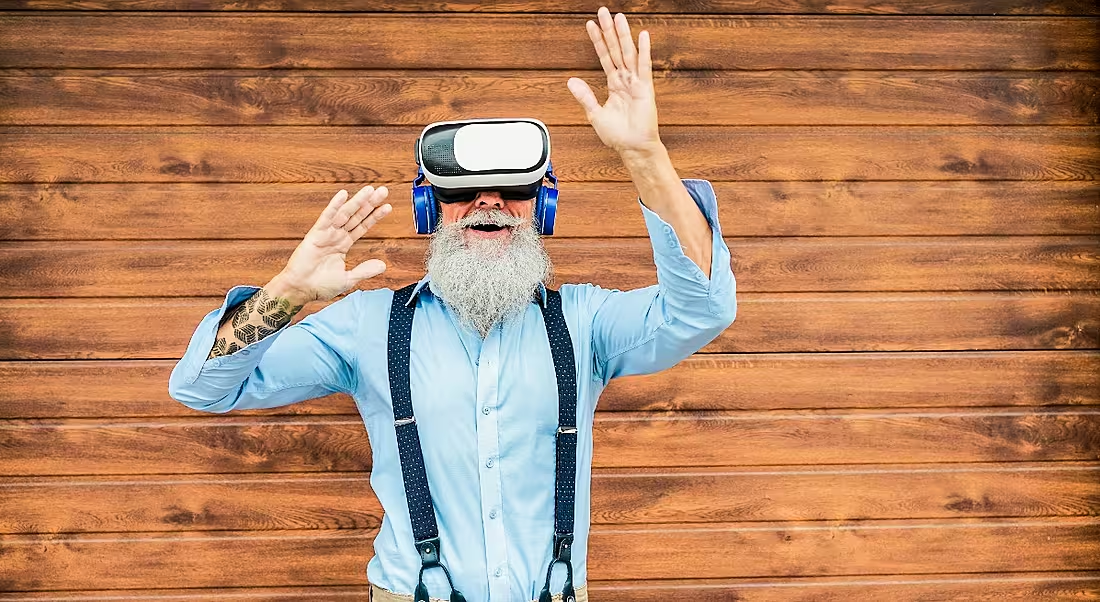Niall Campion’s team at VRAI is already using virtual reality to connect remotely and he believes this tech could transform how we work within our lifetime.
One of the hardest things businesses have had to deal with while working remotely is maintaining connections between team members. This includes practical communication connections but also more emotional connections. According to Niall Campion, virtual reality (VR) technology can help.
Campion is co-founder and director of VRAI, a data-driven simulation company based in Dublin that gives organisations the option to train remotely through virtual reality. Here, Campion shares his own experiences of VR and highlights which skills are needed to embrace this technology.
‘We’re banking on the fact that VR is going to increasingly be part of the workplace of the future’
– NIALL CAMPION
Niall Campion. Image: VRAI
Why are emotional connections important in the workplace?
I immediately think of a project we did in Somalia. We were tasked by the United Nations Mine Action Service to create an experience that allowed the civilian side of the UN in Mogadishu to understand the difficult job the military side do. Basically, they risk their lives every day identifying and disarming improvised explosive devices.
The civilians, while in a war zone, are for the most part safe in their secure compound. We made a VR experience of what it is like outside that compound, then showed that to the civilians working inside. One woman took off the headset and seemed quite moved by the whole thing. I asked her how she felt and she replied, ‘Now I see what my colleagues do’. She was the camp psychologist and her job was to counsel soldiers experiencing post-traumatic stress. Using VR, she now had a strong understanding of what her colleagues did and could empathise with them on a more emotional level.
I guess, for me, caring about what your team does and having the team care about each other always produces better results. Mutual accountability is one of the values we strive towards in VRAI, but this is only possible where emotional connections exist between the team.
What are the challenges to creating and maintaining these connections when working remotely?
Like I’m sure everyone else has experienced, I’ve missed the casual conversations around the office, first thing in the morning or over lunch. We used to do ‘Beat Saber and Beers’ every Friday afternoon in the office before the lockdown. This was a great opportunity for people to come together after a hard week of work and socialise in a more relaxed atmosphere.
We still do a weekly call for the full team on a Friday, but they can get a little unwieldy or awkward. Often people don’t feel comfortable speaking in front of the full group, and it’s hard to have casual or intimate conversations over video calls. Such a large percentage of how we connect with people is via their body language. You can usually tell if someone is having a good or bad day from how they walk through the door in the morning or after lunch. This is much harder on a video call or via a chat window.
What role can VR and AR play in this?
One of the things we started doing after our Friday call was we would all put on our VR headsets and, no matter what part of the country we were in, we could meet virtually. We used a game called Rec Room which allows multiple users to meet in a private, pre-allocated space and play simple games like paintball or dodgeball together.
The VR headsets have microphones and they track your hands and head, so you got a good sense of the person before they even spoke. It was interesting to see that you could generally tell which person was who in the room.
Individuals could branch off and play their own mini games or just have a chat together, which made it much more intimate than a video call.
Another key business activity for us is meeting and presenting to clients. This obviously is difficult in our new reality. We did a project for a customer who wanted to do a big pitch for a potential client. Using an off-the-shelf VR meeting space, we set them up with a branded room with a massive screen in which they could run their presentation.
They shipped VR headsets to their clients who were able to put them on and join them in the virtual presentation space. The overall effect worked really well and again made it possible for one-to-one conversations to happen after the main presentation, which was really valuable. I find it amazing the amount of off-the-shelf tools available, once you know where to look.
Will an increased use of VR in the workplace be a possibility in our lifetime, do you think?
We’re banking on the fact that VR is going to increasingly be part of the workplace of the future. To what degree is still unclear, but we think Covid is going to accelerate the transition, which is why we’ve just closed a follow-on investment round over the summer.
By necessity, companies have had to adapt to new ways of working and training. Where previously it was possible to cram dozens of people into a classroom to sit through traditional training lectures, they now have to be socially distanced. VR both solves this problem and also provides trainees the opportunity to practise the skills they learn in a believable, immersive environment.
Think about any job that involved an apprenticeship where learning was delivered on the job in close proximity to others. How do we do this now? We would argue VR is the ideal solution.
To go back to the question, though, I think we will see it in workplaces in our lifetimes for sure. Like all technology, though some early adopters will embrace it and in fact are already doing so, I think it’ll probably take longer than people are predicting for it to be truly mainstream and as ubiquitous as the personal computer or smartphone have become.
What kinds of skills do people need to incorporate VR and AR into their workplace?
Honestly, it depends on the project. I would suggest that at a basic level, an ability to identify a problem that needs solving and the means to commission a pilot to see if the technology can address that problem.
In a lot of ways, the technology itself is very accessible. The market-leading VR headset is around €450 at the moment and the software to create VR experiences can generally be accessed for free. So, the means of production are theoretically open to everyone.
My background is in the creative industries. I worked in film, TV and animation for 15 years, so I would always say it makes sense to bring in experts who know what they’re doing. The resolution of the video camera on most mobile phones now is better than a lot of professional video cameras from only five years ago. That doesn’t mean everyone with a phone is going to make the next Star Wars or Titanic.
So, in terms of skills, I think a willingness to try new things, bravery or fearlessness that they may not always succeed and flexibility to adapt the project as it progresses for me would be the key skills that the best customers we have worked with would all possess.




